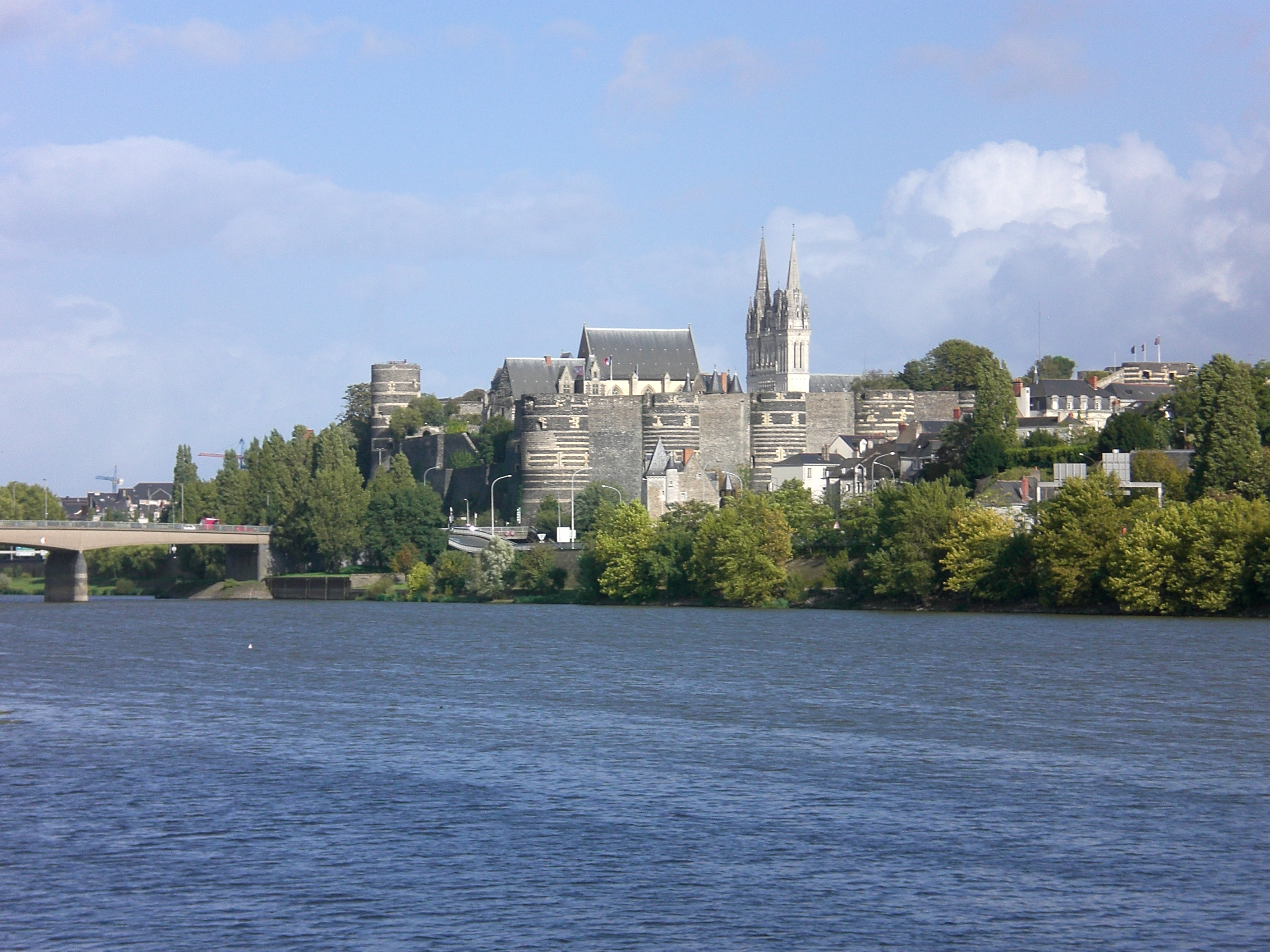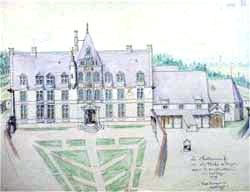|
Jean Delespine
Jean Delespine or Jean de l'Espine (1505–1576), was a French angevin architect of the Renaissance. Biography Jean Delespine was a renowned architect. The Renaissance in Anjou owes much to the artistic and architectural production of this master builder. Today he is attributed about forty works, almost all located in the former province of Anjou. Jean Delespine was, at his beginnings, the student of Jean Mariau, an architect in Angers, to whom he succeeded, in 1535, as ''Commissaire des œuvres et réparations de la ville'' of Angers. Delespine was in charge of important urban developments. He worked under the direction of a succession of mayors, including , and . His official functions were at the origin of contacts with the Controller General of the Bâtiments de France, Philibert Delorme, a great Renaissance architect, ( Palais des Tuileries, Château d'Anet) attached to Anjou as commendatory abbot of the . In 1571, Delespine ceased his duties as curator of the city' ... [...More Info...] [...Related Items...] OR: [Wikipedia] [Google] [Baidu] |
Angers
Angers (, , ) is a city in western France, about southwest of Paris. It is the prefecture of the Maine-et-Loire department and was the capital of the province of Anjou until the French Revolution. The inhabitants of both the city and the province are called ''Angevins'' or, more rarely, ''Angeriens''. Angers proper covers and has a population of 154,508 inhabitants, while around 432,900 live in its metropolitan area (''aire d'attraction''). The Angers Loire Métropole is made up of 29 communes covering with 299,500 inhabitants (2018).Comparateur de territoire INSEE Not including the broader metropolitan area, Angers is the third most populous |
Château D'Ancenis
The Château d'Ancenis is a castle in the town and ''Communes of France, commune'' of Ancenis in the Loire-Atlantique ''Departments of France, département'' of France. The castle is on the bank of the Loire. History The original castle was built in 990 by Aremburga of Ancenis, widow of Guerech, Duke of Brittany, as a motte-and-bailey castle. (A plaque on the castle names Guerech as the constructor, in 984. This is not supported in any documentary sources.) It had simple defences including a moat and a palisade with an enclosure to shelter the population. Owing to its location, it rapidly developed as an ideal place for surveillance of the river, exercising military and economic control. In 1411, the lord and lady of Ancenis were ordered by the authorities to cease detaining boats that passed the castle and extracting punitive tolls on their cargoes. Its strategic position meant that it was subjected to several sieges between the 12th and 16th centuries, by the English kings Henr ... [...More Info...] [...Related Items...] OR: [Wikipedia] [Google] [Baidu] |
16th-century French Architects
The 16th century begins with the Julian year 1501 ( MDI) and ends with either the Julian or the Gregorian year 1600 ( MDC) (depending on the reckoning used; the Gregorian calendar introduced a lapse of 10 days in October 1582). The 16th century is regarded by historians as the century which saw the rise of Western civilization and the Islamic gunpowder empires. The Renaissance in Italy and Europe saw the emergence of important artists, authors and scientists, and led to the foundation of important subjects which include accounting and political science. Copernicus proposed the heliocentric universe, which was met with strong resistance, and Tycho Brahe refuted the theory of celestial spheres through observational measurement of the 1572 appearance of a Milky Way supernova. These events directly challenged the long-held notion of an immutable universe supported by Ptolemy and Aristotle, and led to major revolutions in astronomy and science. Galileo Galilei became a champion ... [...More Info...] [...Related Items...] OR: [Wikipedia] [Google] [Baidu] |
Renaissance Architects
The Renaissance ( , ) , from , with the same meanings. is a period in European history marking the transition from the Middle Ages to modernity and covering the 15th and 16th centuries, characterized by an effort to revive and surpass ideas and achievements of classical antiquity. It occurred after the Crisis of the Late Middle Ages and was associated with great social change. In addition to the standard periodization, proponents of a "long Renaissance" may put its beginning in the 14th century and its end in the 17th century. The traditional view focuses more on the early modern aspects of the Renaissance and argues that it was a break from the past, but many historians today focus more on its medieval aspects and argue that it was an extension of the Middle Ages. However, the beginnings of the period – the early Renaissance of the 15th century and the Italian Proto-Renaissance from around 1250 or 1300 – overlap considerably with the Late Middle Ages, conventionally d ... [...More Info...] [...Related Items...] OR: [Wikipedia] [Google] [Baidu] |
Durtal
Durtal is a commune in the Maine-et-Loire department in western France. It is around 32 km north-east of Angers the department capital. See also *Communes of the Maine-et-Loire department The following is a list of the 177 communes of the Maine-et-Loire department of France. The communes cooperate in the following intercommunalities (as of 2020):Communes of Maine-et-Loire Anjou {{MaineLoire-geo-stub ... [...More Info...] [...Related Items...] OR: [Wikipedia] [Google] [Baidu] |
Les Rosiers-sur-Loire
Les Rosiers-sur-Loire () is a former commune in the Maine-et-Loire department in the Pays de la Loire Region in western France. On 1 January 2018, it was merged into the commune of Gennes-Val-de-Loire. 22 May 2017 The Commune was called "Les Rosiers" until 1993, when it became "Les Rosiers-sur-Loire". The village is in the heart of the , south-east of and north-west of Saumur. Its territory, situated on the banks of the |
Présidial
The presidial courts (french: présidiaux; singular ) were judicial courts of the Kingdom of France set up in January 1551 by Henry II of France Henry II (french: Henri II; 31 March 1519 – 10 July 1559) was King of France from 31 March 1547 until his death in 1559. The second son of Francis I and Duchess Claude of Brittany, he became Dauphin of France upon the death of his elder bro ... with jurisdiction between the '' parlements'' and the bailiwicks. They were suppressed by a decree of the National Constituent Assembly in 1790. References Legal history of the Ancien Régime {{france-hist-stub ... [...More Info...] [...Related Items...] OR: [Wikipedia] [Google] [Baidu] |
Prytanée National Militaire
The Prytanée national militaire is a French military school managed by the French military, offering regular secondary education as well as special preparatory classes, equivalent in level to the first years of university, for students who wish to enter French military academies. The school is located in western France in the city of La Flèche. At first founded in 1604 by the king Henri IV, the school was given to the Jesuits in the aim to "instruct the young people and make it fall in love with sciences, honour and virtue, in order to be able to serve". It then became the "Prytanée" wanted by Napoleon in 1800. History From the Château-Neuf to the creation of the royal college Françoise d'Alençon, who had become a widow in 1537, decided to retire in her land of La Flèche, which she had received as a gift from her husband Charles de Bourbon.Pierre Schilte, ''Le Château-Neuf de Françoise d'Alençon'', Cahiers Fléchois no. 1, 1979. The old feodal castle, actually C ... [...More Info...] [...Related Items...] OR: [Wikipedia] [Google] [Baidu] |
Château De Valençay
Château de Valençay is a château in the commune of Valençay, in the Indre department of France. It was a residence of the d'Estampes and Talleyrand-Périgord families. Although it is part of the province of Berry, its architecture invites comparison with the Renaissance châteaux of the Loire Valley, notably the Château de Chambord. The manor was praised as "one of the most beautiful on earth" by George Sand, who also noted that "no king has owned a more picturesque park". History Château de Valençay is located at the edge of a plateau overlooking the Nahon River. In ancient times, the site of the château was home to a Gallo-Roman villa called ''Valencia us'', the domain of Valans. By the 10th or 11th century, a "heavy and massive tower" had been built, and between 1026 and 1047 a donation charter deeded Valençay to its first recorded lord, Bertrand. In 1220, the then lord of Valençay, Gauthier, was reported to have built a feudal castle or house on the site, but it ... [...More Info...] [...Related Items...] OR: [Wikipedia] [Google] [Baidu] |
Château De Serrant
The Château de Serrant is a Renaissance château situated in the Loire Valley, the private residence of the Prince of Merode. The château is to the west of Angers. It is open to visitors. History The Renaissance château is built on the foundations of a medieval fortress. From the 14th century, it was held by the Brie family. Charles de Brie was inspired to start modernisation early in the 16th century, but lack of funds meant the project was halted with only the North Tower completed. Ownershipthen changed hands several times before Guillaume de Bautru, a State Councillor, purchased the property in 1636. De Bautru restarted the construction that had been halted over a century earlier. By using Charles de Brie's original plans and the same russet schist and white tuffeau stone, de Bautru ensured that there was a continuity of design. The central halls, two wings and the South Tower were added, with Jules Hardouin Mansart completing the work of de Bautru by building the c ... [...More Info...] [...Related Items...] OR: [Wikipedia] [Google] [Baidu] |
La Flèche
La Flèche () is a town and commune in the French department of Sarthe, in the Pays de la Loire region in the Loire Valley. It is the sub-prefecture of the South-Sarthe, the chief district and the chief city of a canton, and the second most populous city of the department. The city is part of the Community of communes of the Pays La Flèche. The inhabitants of the town are called ''Fléchois''. It is classified as an area of art and history. The Prytanée National Militaire is located in La Flèche. Geography La Flèche is located on the Loir River and is also on the Greenwich Meridian. It is located halfway between Le Mans (45 km) and Angers. City communes * Sainte-Colombe * Saint-Germain-du-Val * Verron Neighboring municipalities * Bazouges Cré sur Loir * Crosmières * Villaines-sous-Malicorne * Bousse * Clermont-Créans * Mareil-sur-Loir * Thorée-les-Pins * Baugé-en-Anjou (Maine-et-Loire) History The origin of the name ''La Flèche'' is uncertain; th ... [...More Info...] [...Related Items...] OR: [Wikipedia] [Google] [Baidu] |
Tomb
A tomb ( grc-gre, τύμβος ''tumbos'') is a :wikt:repository, repository for the remains of the dead. It is generally any structurally enclosed interment space or burial chamber, of varying sizes. Placing a corpse into a tomb can be called ''immurement'', and is a method of Disposal of human corpses, final disposition, as an alternative to cremation or burial. Overview The word is used in a broad sense to encompass a number of such types of places of interment or, occasionally, grave (burial), burial, including: * Shrine, Architectural shrines – in Christianity, an architectural shrine above a saint's first grave (burial), place of burial, as opposed to a similar shrine on which stands a reliquary or feretory into which the saint's remains have been transferred * Burial vault (tomb), Burial vault – a stone or brick-lined underground space for multiple burials, originally vault (architecture), vaulted, often privately owned for specific family groups; usually benea ... [...More Info...] [...Related Items...] OR: [Wikipedia] [Google] [Baidu] |






